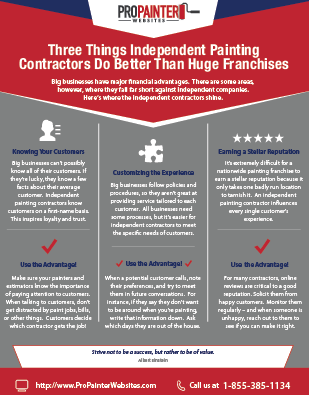Seasonal Factors To Consider For Industrial Exterior Painting: What You Need To Know
Seasonal Factors To Consider For Industrial Exterior Painting: What You Need To Know
Blog Article
Material Author-Ford Rodriquez
When you're intending a business outside painting project, seasonal factors can make or break your outcomes. You'll intend to take into consideration how temperature level and humidity influence paint application and drying times. Selecting the right season can guarantee your paint adheres correctly and lasts much longer. Yet which periods are genuinely the most effective for this sort of work? Let's discover the key elements that can impact your job's success.
The Influence of Temperature on Paint Application
When you're intending a business outside paint task, the temperature can dramatically affect how well the paint sticks and dries.
Ideally, you intend to repaint when temperature levels vary in between 50 ° F and 85 ° F. If it's also chilly, the paint may not heal properly, resulting in concerns like peeling or cracking.
On the flip side, if it's as well hot, the paint can dry too promptly, preventing appropriate attachment and causing an irregular finish.
You ought to also take into consideration the time of day; morning or late afternoon offers cooler temperatures, which can be more favorable.
Always examine the maker's suggestions for the particular paint you're utilizing, as they typically supply assistance on the suitable temperature range for optimum outcomes.
Humidity and Its Impact on Drying Times
Temperature isn't the only ecological factor that affects your business outside paint job; moisture plays a considerable role too. High humidity degrees can reduce drying out times substantially, affecting the overall top quality of your paint job.
When the air is filled with dampness, the paint takes longer to treat, which can lead to concerns like bad attachment and a greater danger of mildew growth. If https://indoorpaintersnearme67776.bleepblogs.com/35609746/uncover-the-vital-pointers-for-picking-a-dependable-paint-contractor-for-your-task-guaranteeing-that-both-top-quality-and-budget-are-in-sync on an especially humid day, be prepared for extended wait times in between coats.
It's vital to keep track of neighborhood weather and plan as necessary. Preferably, go for humidity levels in between 40% and 70% for optimal drying out.
Maintaining these factors in mind ensures your job remains on track and supplies an enduring coating.
Best Seasons for Commercial Exterior Paint Projects
What's the best season for your industrial exterior painting jobs?
average cost per sq ft to paint interior and early fall are commonly your best choices. During these periods, temperatures are mild, and moisture degrees are usually lower, creating perfect problems for paint application and drying.
Prevent summertime's intense heat, which can trigger paint to completely dry too promptly, causing inadequate bond and finish. Likewise, wintertime's cool temperatures can impede appropriate drying out and healing, risking the longevity of your paint work.
Go for days with temperatures between 50 ° F and 85 ° F for ideal outcomes. Remember to examine the regional weather report for rain, as wet problems can spoil your project.
Planning around these aspects guarantees your paint project runs smoothly and lasts much longer.
Verdict
Finally, intending your business outside painting tasks around seasonal considerations can make a substantial distinction in the end result. By organizing job during the optimal temperature levels and humidity levels, you'll guarantee better adhesion and drying times. Bear in mind to watch on local weather prediction and pick the right time of year-- springtime and early autumn are your best choices. Taking these steps will help you achieve a resilient and professional coating that lasts.
